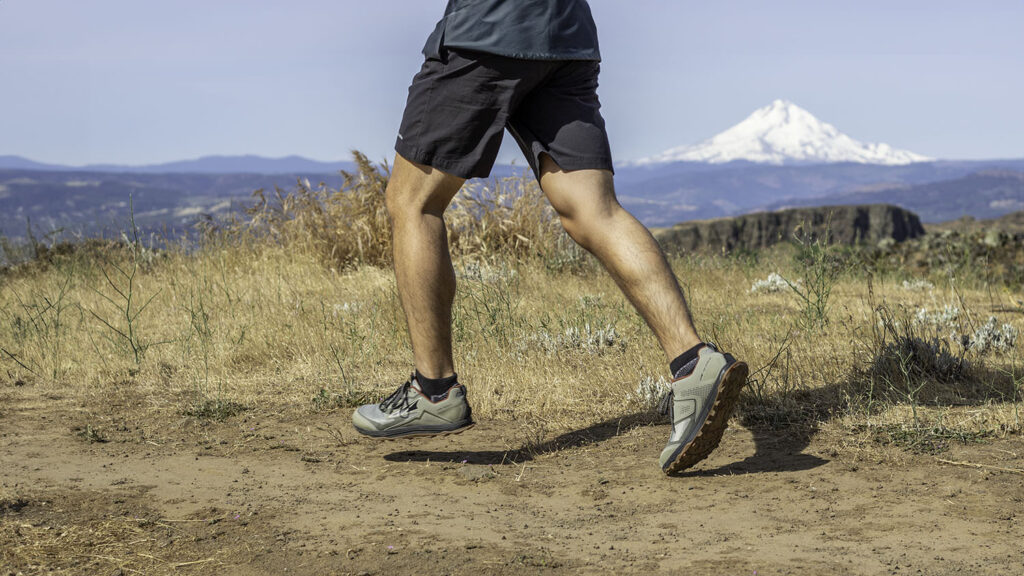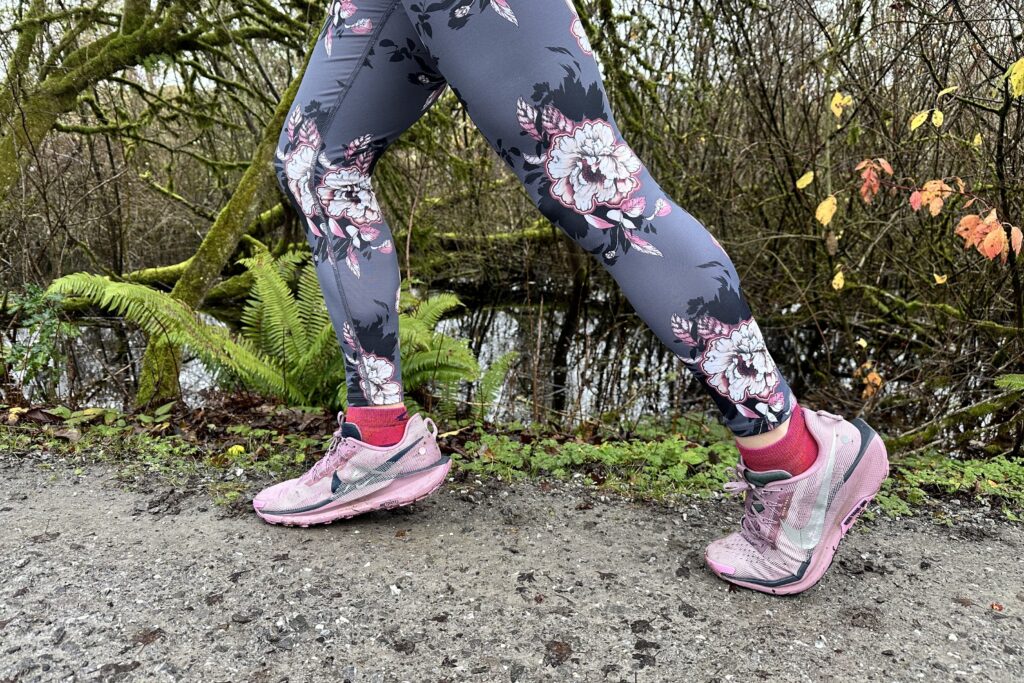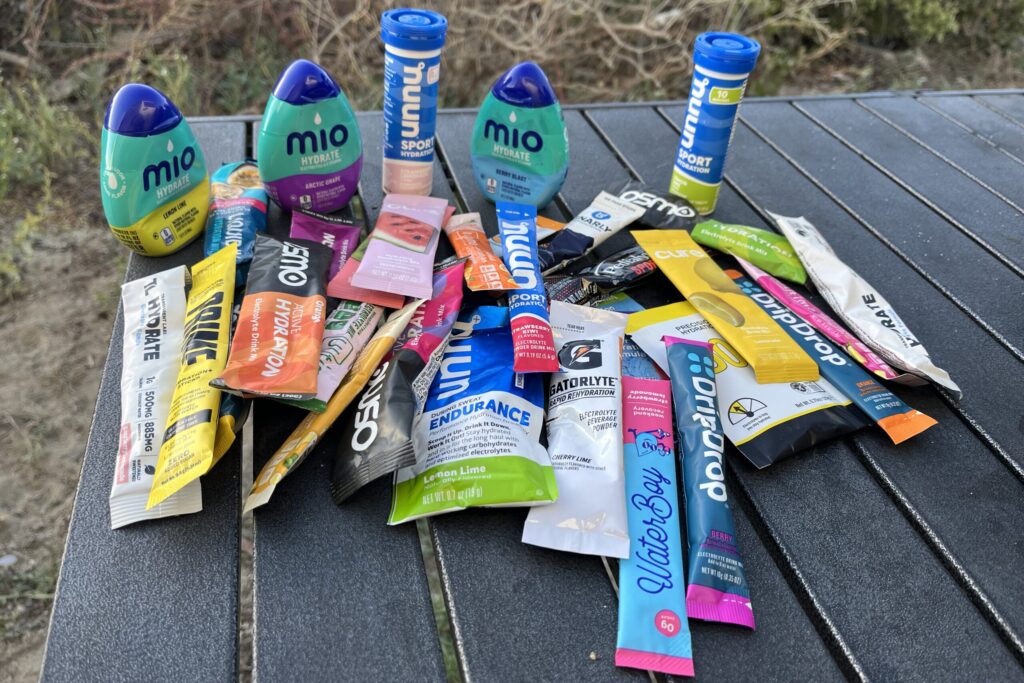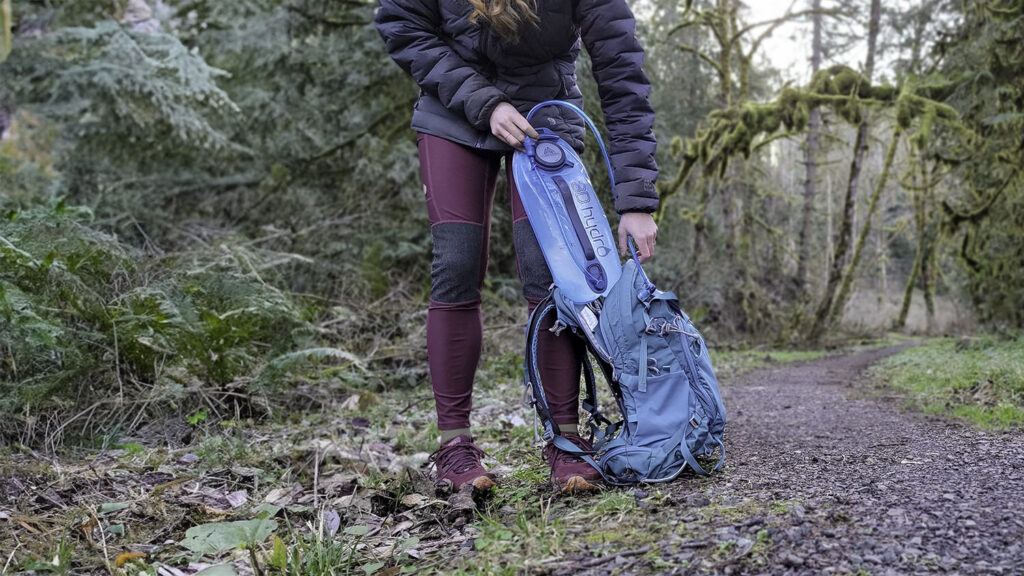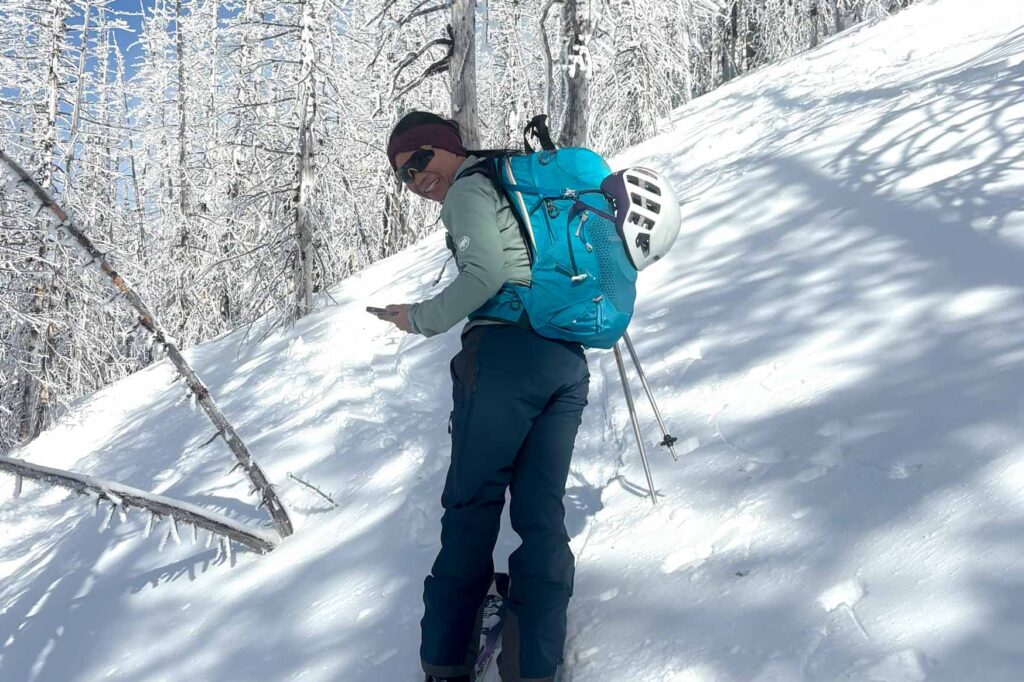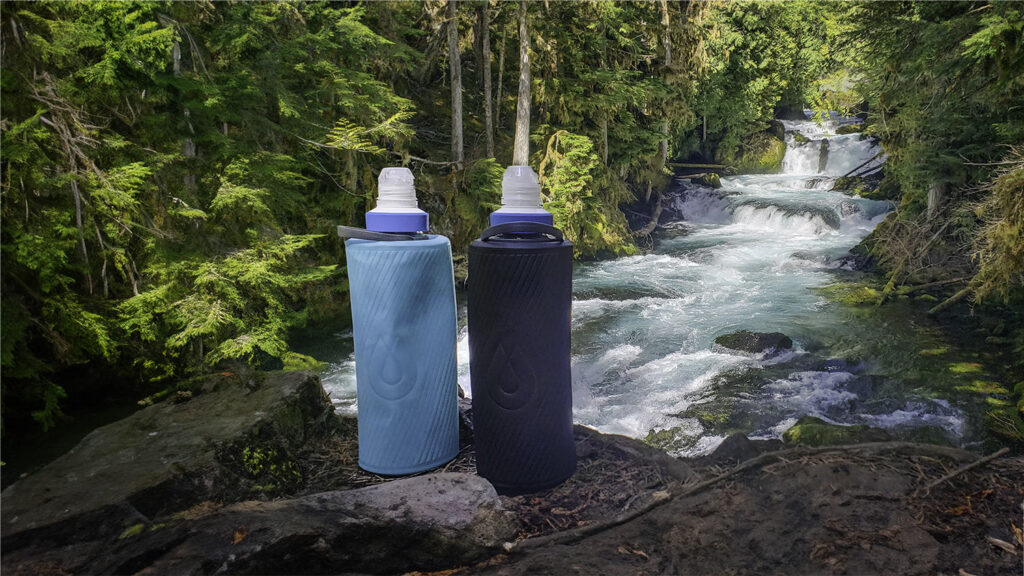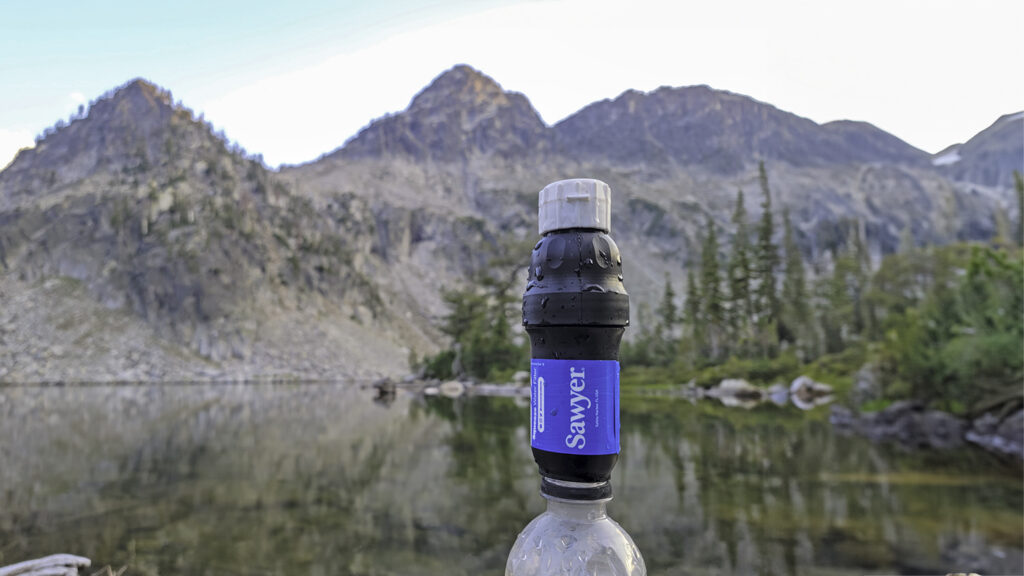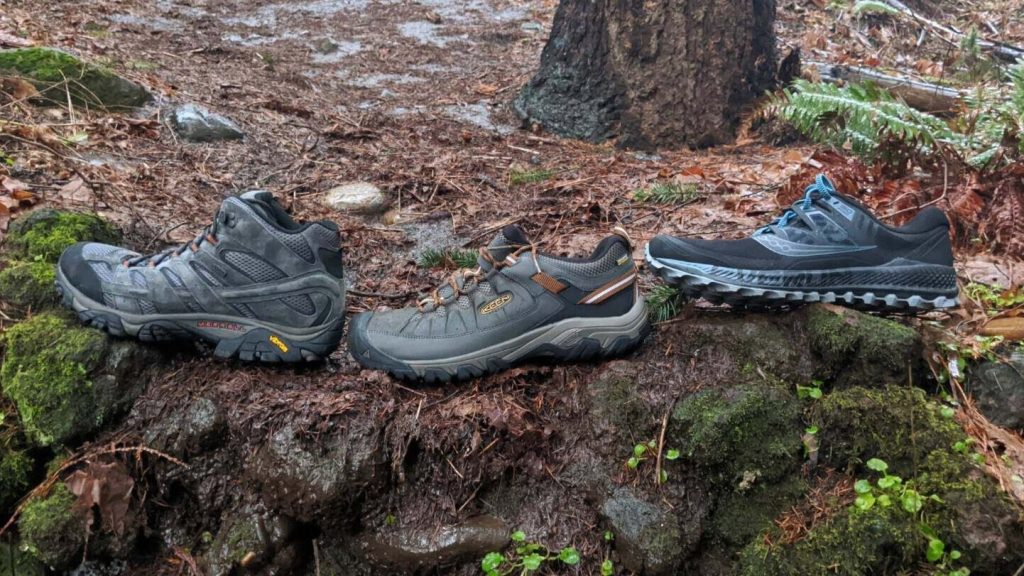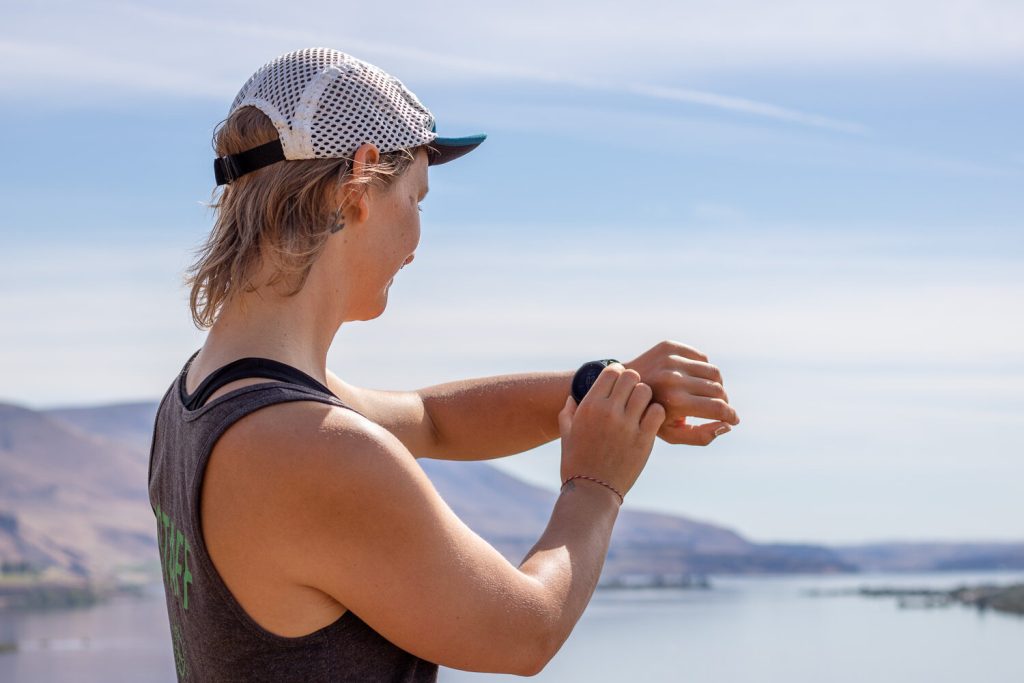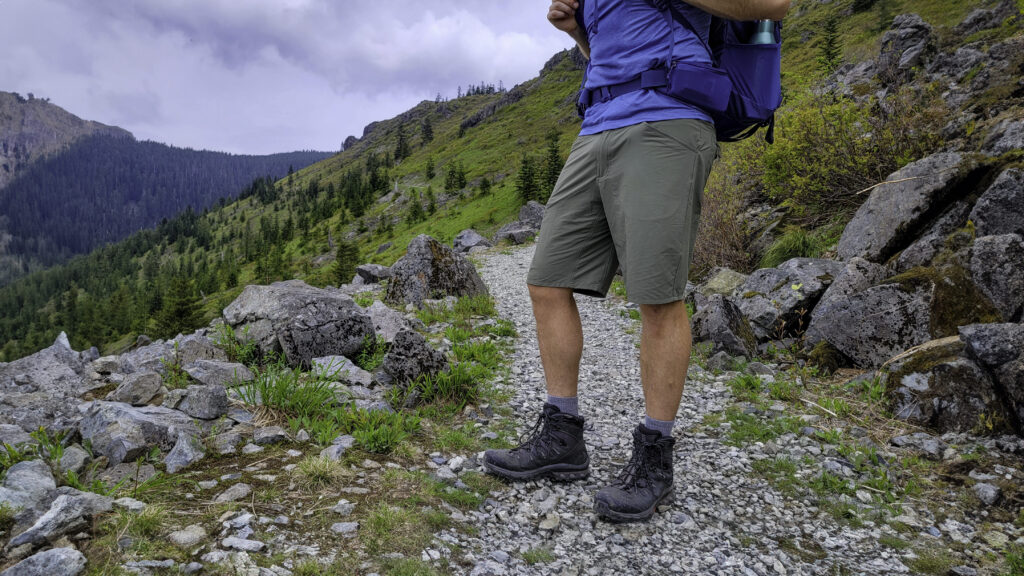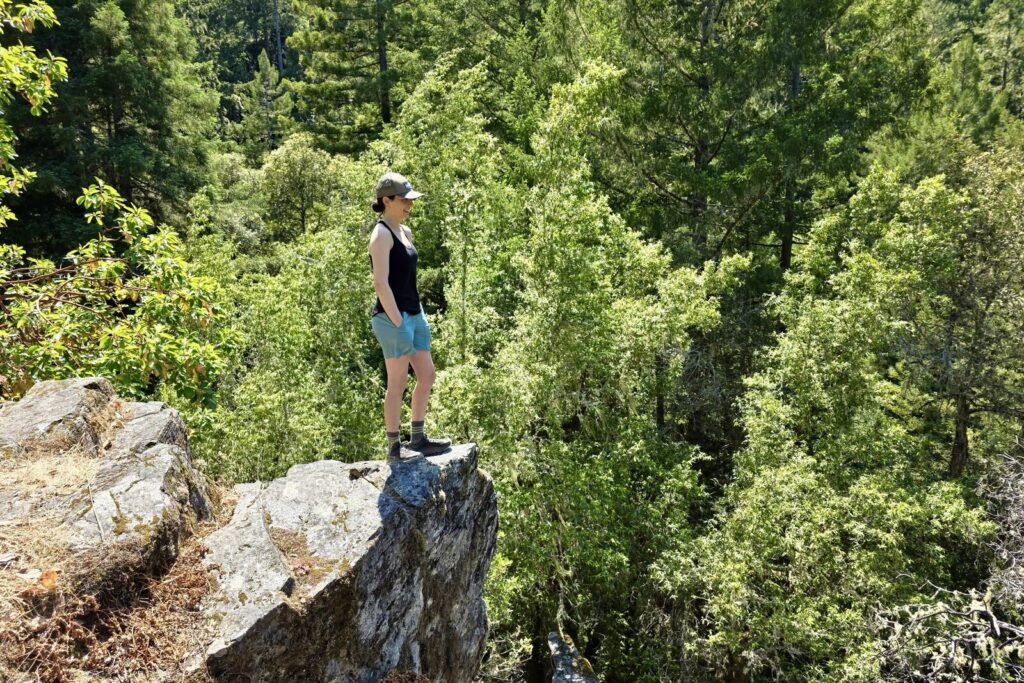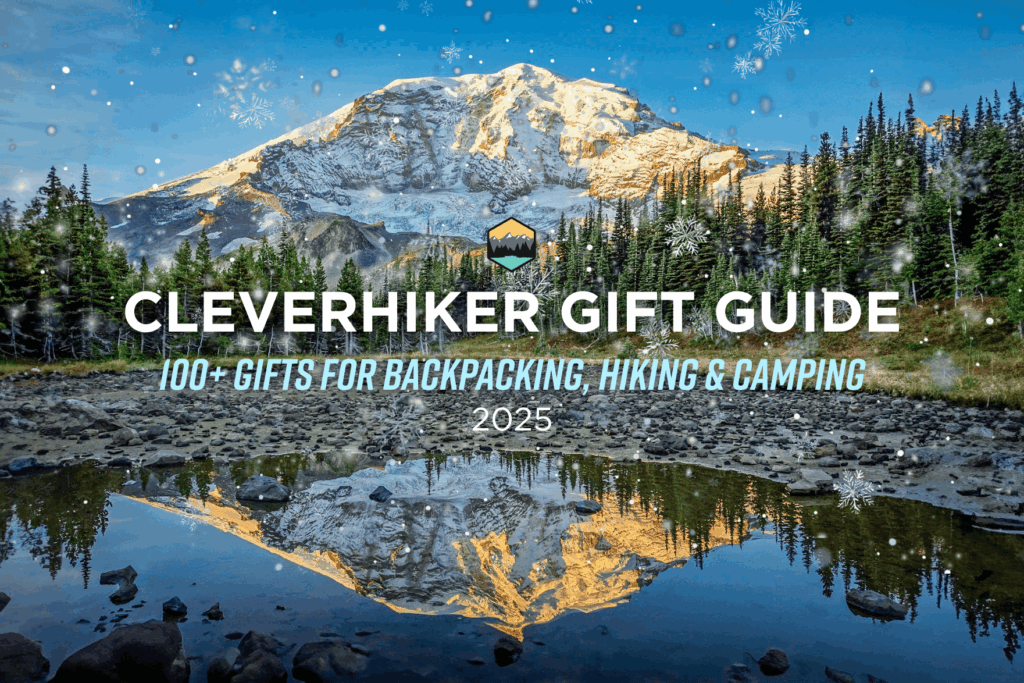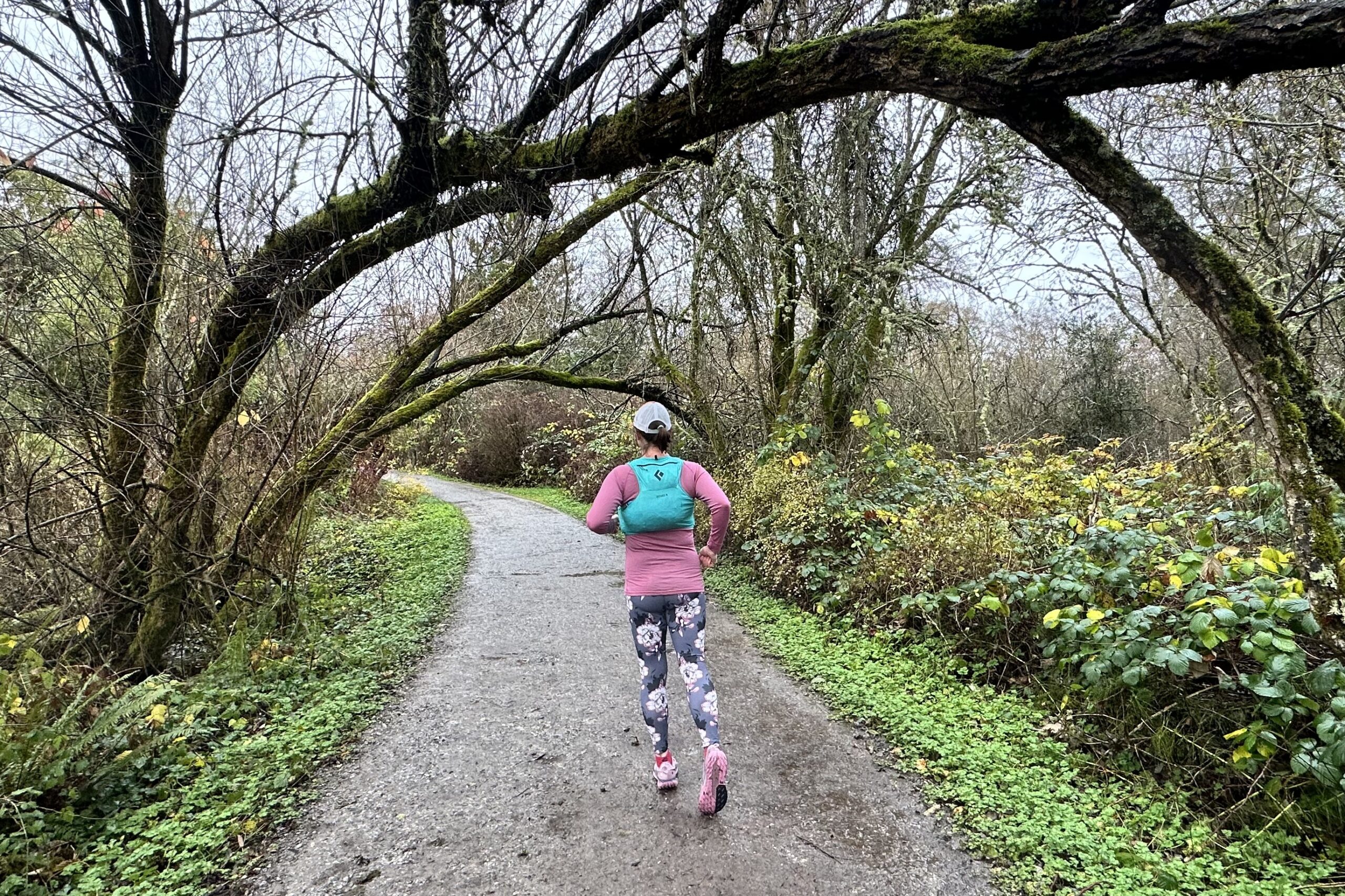
Our team knows running vests. Lead gear analyst Heather Anderson has logged 50,000 foot-miles and holds self-supported fastest known times on multiple long-distance trails. As an avid trail runner, she gathered the best running vests for racing and training, testing them on trails throughout the Pacific Northwest.
We loaded these packs for long days on the trail as well as for shorter outings where we just needed to store a few items. Ready to keep your hands free while having everything you need at your fingertips? Check out our top picks from brands like Ultimate Direction, Salomon, Nathan, and more.
And for more info, check out some of our other popular gear guides:
Quick Picks for Running Vests
Check out this quick list of our favorites if you’re in a hurry, or continue scrolling to see our full list with in-depth reviews.
Best Overall Running Vest: Ultimate Direction Ultra Vest 6.0 – Men’s ($150) / Women’s ($150)
Best Running Vest for Daily Training: Black Diamond Distance 4 – Men’s ($150) / Women’s ($150)
Best Budget Running Vest: Ultraspire Alpha 5.0 Race Vest ($125)
Best Running Vest for Racing: Nathan Pinnacle 4 Liter Hydration Race Vest – Men’s ($180)/ Women’s ($180)
Best Running Vest for Long Runs: Nathan Pinnacle 12 Liter Hydration Race Vest – Men’s ($200) / Women’s ($200)
Best Running Vest for Cool Weather: Salomon ADV Skin 5 ($145)
Best Running Vest with Helmet Compatibility: Arc’Teryx Norvan 7 Vest – Men’s ($180) / Women’s ($180)
Best Running Vest for Versatility: Salomon ADV Skin 12 ($165)
Running Vest Made from 100% Recycled Materials: Osprey Dyna 6 – Men’s ($130) / Women’s ($130)
What’s new
We’ve expanded our Best Running Vests Gear Guide by testing and including packs from more manufacturers such as Ultraspire, Osprey, and Black Diamond. We’ve also added women’s versions to the guide lineup.
- The Ultimate Direction Ultra Vest and Vesta 6.0 Hydration Vest take top spot as our pick for Overall Best Running Vest
- The Ultraspire Alpha 5.0 Race Vest ranks as one of our best packs as well as our top Budget Buy.
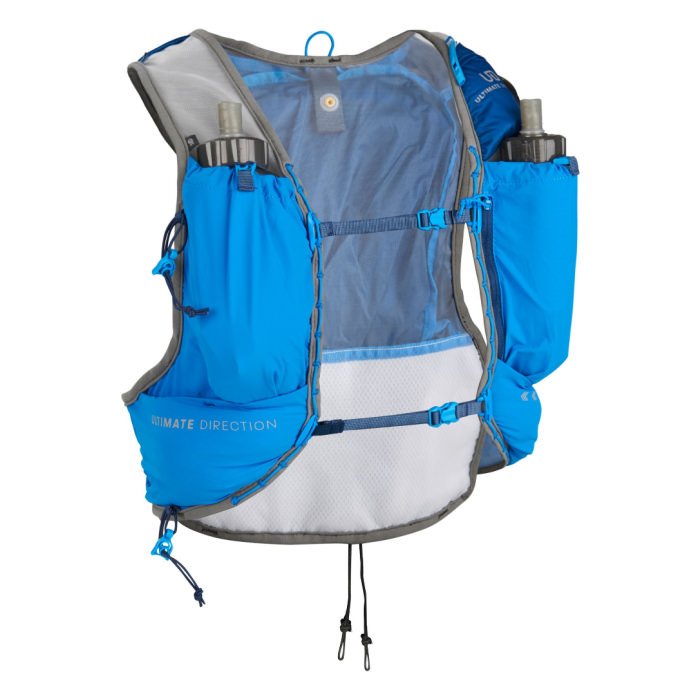
Ultimate Direction Ultra Vest 6.0
Best Overall Running Vest
CleverHiker Rating: 4.9/5.0
Price: $150
Capacity: 10.3L
Reservoir Compatible: Yes, two flasks included
Sizing: Men’s & Women’s
Pros
- Extremely comfortable
- Excellent organization
- High capacity
- Adjustable sternum buckle closure
Cons
- No Insulation for the hydration sleeve
- Hard to access rear pockets on the move
- Lots of bouncing cords
The Ultimate Direction Ultra Vest 6.0 (or Women’s Vesta) stands out as our top choice, offering an impressive combination of lightness, storage, and durability. This vest features eight pockets located on the chest straps alone. Some pockets are breathable, while others are water-resistant, and many include zippers or hook-and-loop tape closures.
Essentially, there’s a spot for nearly everything you might want to carry, along with ample storage in the back that comprises a spacious zippered main compartment and an external cinch for a lightweight jacket or hat.
However, it can be tricky to reinsert the bottles into the front pockets while running due to the locking closure system, which takes some practice. Additionally, the hard plastic tops of the bottles can occasionally rub against your chest, potentially causing bruising or chafing during longer runs.
One thing to note is that the smaller pockets at the top of each chest strap are only attached on the sides. This design can make it easy to inadvertently drop items behind the pockets when attempting to put them inside, causing them to fall to the ground.

Black Diamond Distance 4
Best Running Vest for Daily Training
CleverHiker Rating: 4.9/5.0
Price: $150
Capacity: 10.3L
Reservoir Compatible: Yes, two flasks included
Sizing: Men’s & Women’s
Pros
- Comfortable
- Great organization
- Easy access pockets
- Secure fit
Cons
- No Insulation for the hydration sleeve
- Hard to access rear pockets on the move
- Lots of bouncing cords
The Black Diamond Distance 4 (men’s / women’s) is a versatile and minimalist hydration vest, perfect for both training sessions and race days, making it an excellent choice for runners seeking an all-in-one solution. The stretch fabric of this second-generation model molds to your body, ensuring no bouncing or chafing. It is also available in a women’s specific version and a variety of sizes, making it easy to find the right fit.
During our testing on the trails of Bellingham, Washington, this vest excelled across all metrics. Whether loaded up for a long run or carrying just the essentials on a quick outing, the Distance 4 offered excellent organization, a comfortable fit, and outstanding performance.
Notable features include a convenient Z-pole carry system over the shoulder, easily accessible side and front pockets, and dual flask pockets that come with HydraPak® SoftFlasks™. This makes it ideal for runners wanting a versatile hydration and storage solution.
The Distance 4 stands out for its exceptional breathability and light colors, which help regulate temperature in hot conditions while also being soft and chafe-free in wet weather. Lightweight and breathable, this fully-featured pack is perfect for both training and race days. Its comfortable fit and user-friendly pockets guarantee a high-performance experience wherever you run.
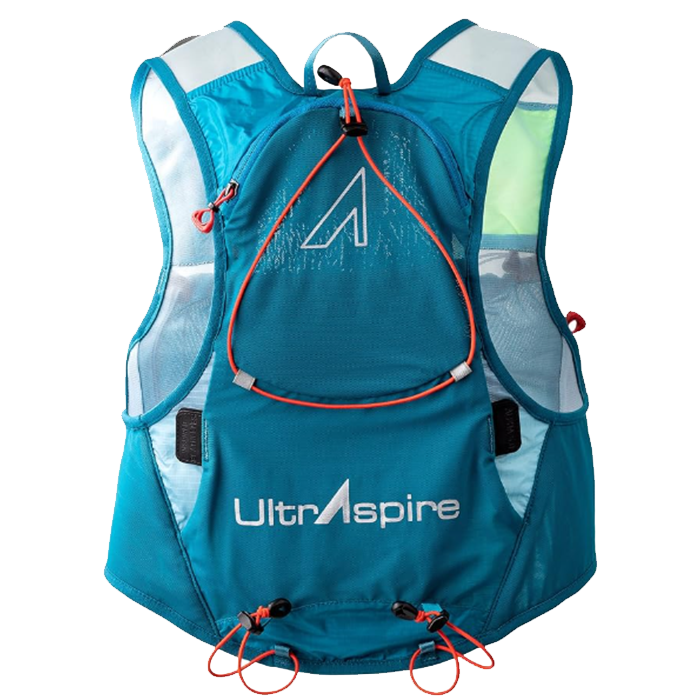
Ultraspire Alpha 5.0
Best Budget Running Vest
CleverHiker Rating: 4.9/5.0
Price: $125
Capacity: 6L
Reservoir Compatible: Yes, not included
Sizing: Unisex
Pros
- Highly breathable
- Extremely comfortable
- Great organization
- Insulated hydration sleeve
- Easy access pockets
- Great price point
Cons
- Magnet closures sometimes get in the way
- Bungee sternum straps are a bit fussy
The UltrAspire Alpha 5.0 Race Vest offers outstanding value by combining versatility and functionality at a more affordable price than many competitors, earning it the title of our Best Budget Buy. The design includes double-layer side pockets, a shock cord for pole attachment, and improved magnetic closures on the rear pocket. Although we occasionally found the magnets a bit finicky, having nine pockets allowed us to stay organized without stopping. The removable insulated hydration sleeve liner kept our water cool, and the bungee cord provided a convenient way to attach extra gear.
Our testers thoroughly enjoyed using the Alpha 5.0 during their training runs on the trails of the Pacific Northwest. With ample storage options, compatibility for both flasks and a reservoir, as well as shock cord attachments for trekking poles and additional gear, it serves as an excellent hydration and storage solution for runs of any distance. Runners in hot climates will appreciate its high breathability and moisture management, while those in milder regions will benefit from the ultracool system during more demanding workouts.
Overall, this vest is a superb choice for anyone looking for performance, breathability, and practicality, whether for racing or training. Those in search of a thoughtfully designed, comfortable race pack or a well-organized hydration vest for extended mountain runs will find significant value here.
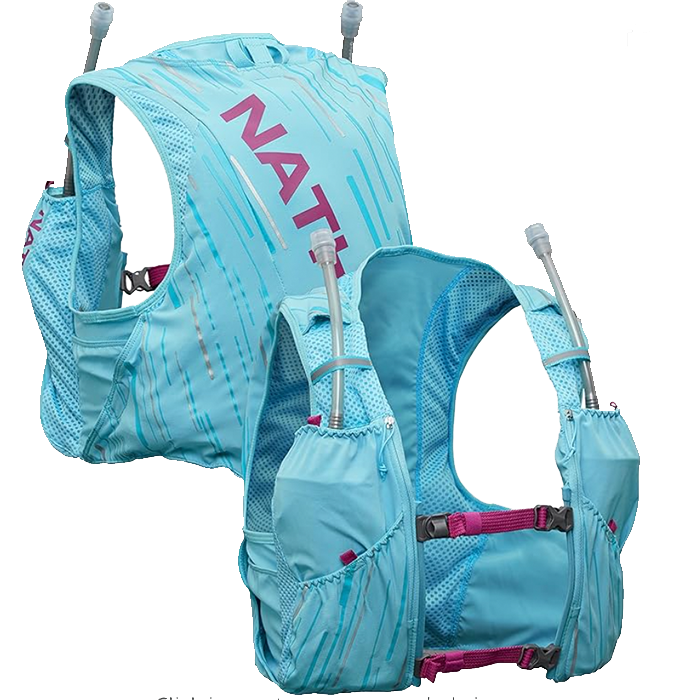
Nathan Pinnacle 4 Liter
Best Running Vest for Racing
CleverHiker Rating: 4.8/5.0
Price: $180
Capacity: 4L
Reservoir Compatible: Yes, not included
Sizing: Men’s & Women’s
Pros
- Lightweight
- Breathable
- Bounce-free fit
- Easy access pockets
Cons
- Expensive
- Straws can bounce if not secured
The Nathan Pinnacle 4 is an ultra-lightweight premium vest designed for both casual runners and those seeking an efficient storage and hydration system for race day. Its flexible hydration options allow you to choose between the included straw-top flasks or a reservoir.
With comfortable, moisture-wicking fabrics and a secure fit, this no-bounce pack makes it easy to forget you’re wearing it, enabling you to focus on running.
Despite its compact 4-liter capacity, the organization is impressive, featuring a thoughtfully arranged selection of accessible pockets for securely stowing snacks, gear, and valuables. The user-friendly clasp buckles on the sternum straps, along with gender and size-specific options, ensure you can find the perfect fit.
We loved the soft, quick-drying materials that kept us comfortable during our more challenging runs in the Chuckanut Mountains of Washington. This vest is a versatile choice for both training and racing, making it a smart investment for a diverse range of runners.
More: Nathan Pinnacle 4 Liter Hydration Race Vest Full Review
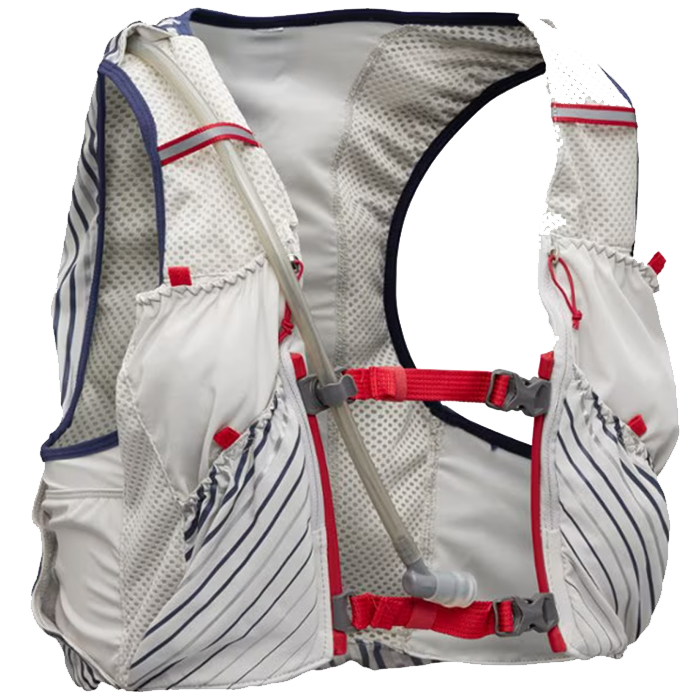
Nathan Pinnacle 12 Liter
Best Running Vest for Long Runs
CleverHiker Rating: 4.7/5.0
Price: $200
Capacity: 12L
Reservoir Compatible: Yes, 1.6 L insulated bladder included
Sizing: Unisex XS-XL
Pros
- Bounce free
- Multiple pockets for optimal organization
- Insulated bladder
- Magnet hose dock
- Waterproof lining on front pockets
Cons
- Small items might get lost in bigger pockets
- Side pockets are difficult to access
- Expensive
The Nathan Pinnacle 12 L Hydration Race Vest is a spacious option that can accommodate all your essentials along with hydration for a full day of adventure or racing. Equipped with 13 exterior pockets, a hydration sleeve, and a magnetic clip for the included insulated bladder, this vest features adjustable buckle sternum straps that ensure a secure fit without any bounce.
We tested it on long mountain runs, daily training sessions, and even running errands around town. When fully loaded, it remained comfortable, and the hook-and-loop tape closures ensured the pockets’ contents stayed secure. We were impressed by the soft, quick-drying fabrics that prevented chafing—even during rainy runs.
The Pinnacle series delivers all the performance Nathan is known for, but in a vest that is 20% lighter than their other packs. This vest offers exceptional value for runners seeking an ultralight, high-capacity vest that fits snugly. Ultramarathon runners, in particular, will appreciate the lightweight design, which helps reduce fatigue when carrying a lot of gear.
If a lightweight carry-all is what you’re after, this vest might be the perfect match for you, earning our designation as the Best Vest for Long Runs.
More: Nathan Pinnacle 12 Liter Hydration Race Vest Full Review

Salomon ADV Skin 5
Best Running Vest for Cool Weather
CleverHiker Rating: 4.7/5.0
Price: $145
Capacity: 5L
Reservoir Compatible: Yes, soft flasks included
Sizing: Unisex
Pros
- No bounce fit
- Easy adjust closure
- Lots of pockets for organization
- Removable insulated panel for hydration reservoir
Cons
- Snug fit can be too warm
The Salomon ADV Skin 5 vest is an excellent choice for hydration and storage, whether you’re racing or training. This vest makes it easy to stay organized and hydrated on the go, whether you opt for a reservoir or the included soft flasks. With a storage capacity of five liters, it offers plenty of space for your gear, snacks, and extra layers, making it ideal for short to medium-length outings.
This vest features Salomon’s Sensifit construction, ensuring a secure, bounce-free fit, no matter how much you carry. The bungee cord sternum adjuster is easy to tighten and stays firmly in place, and the trekking pole attachments are convenient for on-the-go use.
We tested this pack during medium-length training runs and shorter daily routes on the hilly trails around Bellingham, Washington, and found it to be an excellent choice for runners seeking an all-around training vest. It excels in versatility and functionality by offering ample, easily accessible storage with a secure fit. The only downside was that the close fit made it feel slightly warm on hot days.
Those who predominantly run or race in hot or humid conditions might find it less suitable than other options. For everyone else, this vest could quickly become your go-to for everything from short training sessions to longer runs and race day.

Arc’teryx Norvan 7
Best Running Vest with Helmet Compatibility
CleverHiker Rating: 4.3/5.0
Price: $160
Capacity: 7L
Reservoir Compatible: No
Sizing: Men’s & Women’s
Pros
- Comfortable fit
- Lot of organization
- Stretchy pockets hold a lot
Cons
- Not Secure
- Bounces
The Arc’Teryx Norvan 7 Vest is designed to be ultra-lightweight with a snug fit for security. It offers just the right amount of storage for your essentials: a jacket, some snacks, and hydration, while also providing extra attachment points for technical gear like trekking poles, a helmet, and an ice axe when your run gets a bit more serious.
Two flasks are included, and the pockets are tailored for easy access to everything you need while on the run. However, we noticed that the absence of pocket closures can feel somewhat insecure when the vest isn’t completely full. We found that some items were prone to bouncing out when moving quickly on uneven terrain. Additionally, the thin sternum straps and hook closures may become a bit tricky to manage, especially with cold fingers or while wearing gloves. Nonetheless, these minor drawbacks don’t diminish the vest’s overall value.
The Norvan 7 is ideal for those seeking an ultralight, highly breathable vest for light and fast alpine runs as well as race day use. However, smaller runners or anyone not carrying much might find that it feels a bit floppy.

Salomon ADV Skin 12
Best Running Vest for Versatility
CleverHiker Rating: 4.1/5.0
Price: $165
Capacity: 12L
Reservoir Compatible: Yes, reservoir not included
Sizing: Unisex
Pros
- No bounce fit
- Easy adjust closure
- Lots of pockets for organization
- Removable insulated panel for hydration reservoir
Cons
- Chafes in some areas
- Snug fit can be hot
The Salomon ADV Skin 12 Hydration Vest is our top choice for overall versatility. Suitable for your local trails or mountain adventures, this vest features 3D Air Mesh fabric that breathes well and dries quickly. However, the close fit made us sweatier than other models, particularly on hot days.
A standout feature is the innovative chest strap system with multiple connection points, allowing for easy fit adjustments without the hassle of sliding rails or toggles. While the elastic loops do a good job of securing the front water bottles, getting them back into their pockets while moving can be challenging.
Overall, the Salomon ADV Skin 12 is well-designed, with intuitive pocket placement that includes eight easily accessible pockets. Additionally, there are two large zippered pockets on the chest straps for securing larger items.
The adjustable shoulder straps also help minimize unwanted bounce while running. It comes with two 500 mL bottles, but note that a reservoir is not included. Our only concern with the fit was that the collar chafed the base of our neck, even during shorter outings.
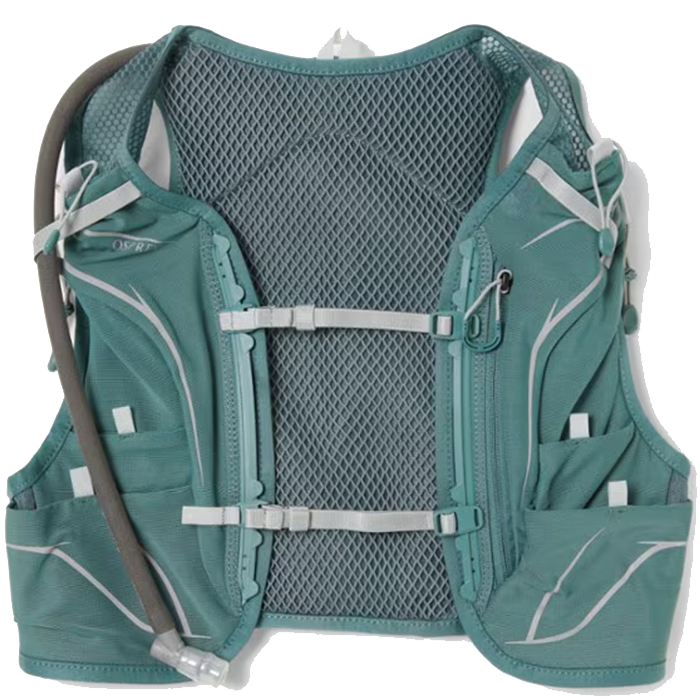
Osprey Dyna 6
Running Vest Made from 100% Recycled Materials
CleverHiker Rating: 4.0/5.0
Price: $130
Capacity: 6L
Reservoir Compatible: Yes, 1.5 L bladder included
Sizing: Men’s & Women’s
Pros
- Durable fabric
- Recycled materials
- Lots of organization
- Secure pockets
Cons
- Rough fabric
- Not as breathable as other options
Whether you choose the men’s Duro 6 or the women’s Dyna 6, Osprey has created a highly durable and versatile running vest. Both vests come equipped with a 1.5-liter reservoir and 13 pockets that provide convenient places to stash your gear, snacks, and layers.
The organization offered by this pack makes it an excellent choice, whether you’re heading out for a full day on the trails or tackling your daily training route. The zippered front and back pockets keep your essentials secure, and there are attachment points for trekking poles.
Designed with sustainability in mind, both vests are made from recycled materials and feature easy-access pockets and a hydration sleeve, allowing you to stay on the move without interruption.
Our only minor issue was that the hydration hose could benefit from a magnet or clip to prevent it from swinging around. We had to tuck it into a pocket when not in use to keep it from bouncing distractingly.
The sternum strap includes a plastic clip rail adjustment that allows for a personalized fit, though we found it to feel a bit rigid and uncomfortable at times. Aside from that, this vest is a solid option for those seeking a durable, flexible choice for both mountain adventures and weekly training runs.
With its sturdy construction, it promises great value over time. However, runners in warmer, humid climates might find it a little too warm and slower to dry compared to other options.
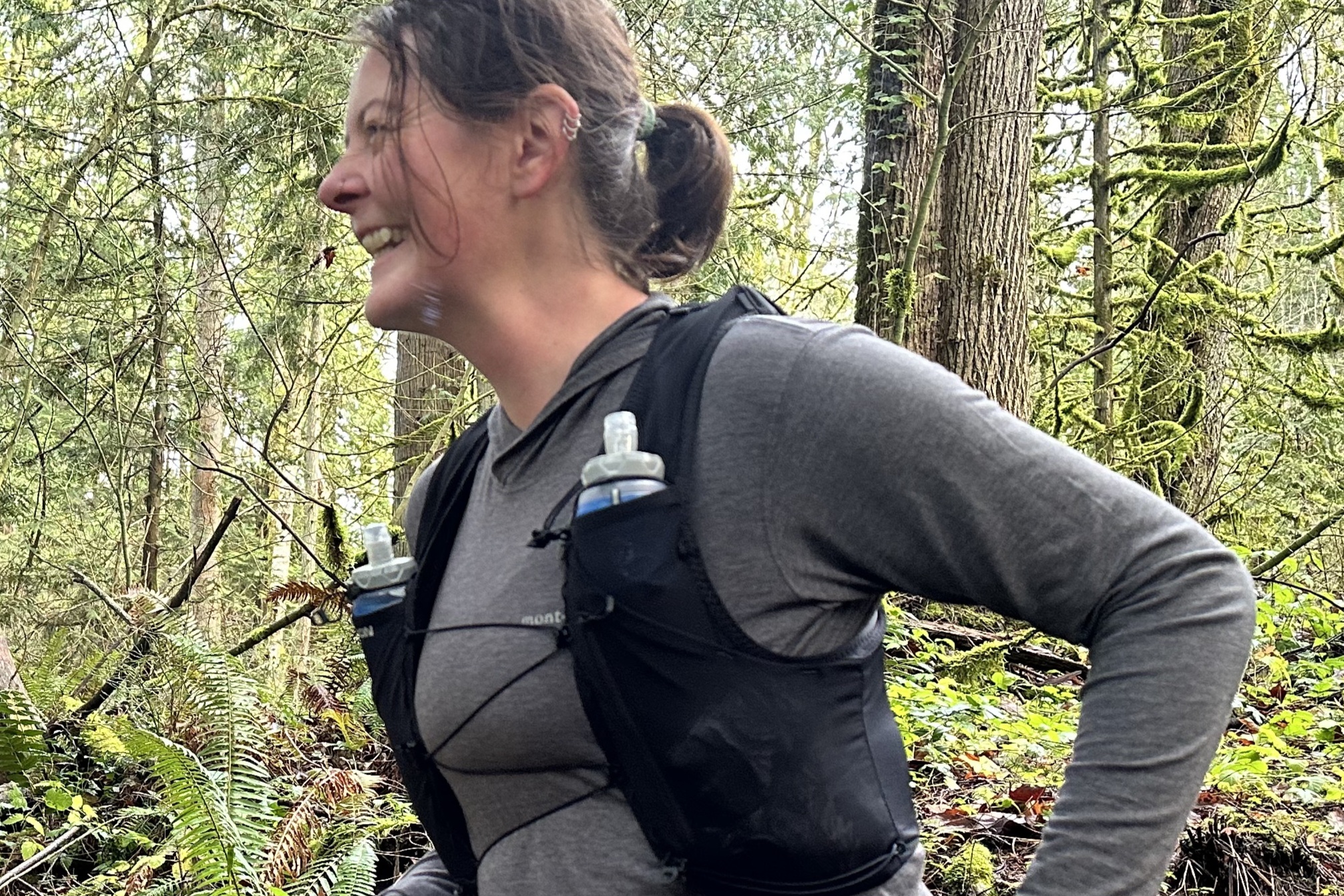
Product Comparison Table
| oSort | Product | Price | Capacity | Reservoir Compatible | Sizing | Comfort & Fit | Functionality | Performance | Durability | Breathability | 0 |
Ultimate Direction Ultra Vest 6.0 View Men's View Women's |
$150 | 10.3L | Yes, two flasks included | Men’s & Women’s | 5.0 | 5.0 | 5.0 | 4.8 | 4.9 | 1 |
Black Diamond Distance 4 View Men's View Women's |
$150 | 10.3L | Yes, two flasks included | Men’s & Women’s | 4.9 | 5.0 | 5.0 | 4.8 | 4.9 | 2 |
Ultraspire Alpha 5.0 View at Amazon View at Walmart |
$125 | 6L | Yes, not included | Unisex | 4.9 | 5.0 | 5.0 | 4.8 | 4.9 | 3 |
Nathan Pinnacle 4 Liter View at Amazon View at Nathan |
$180 | 4L | Yes, not included | Men’s & Women’s | 4.8 | 4.8 | 4.8 | 4.7 | 4.7 | 4 |
Nathan Pinnacle 12 Liter View Men's View Women's |
$200 | 12L | Yes, 1.6 L insulated bladder included | Unisex XS-XL | 4.8 | 4.5 | 4.8 | 4.7 | 4.7 | 5 |
Salomon ADV Skin 5 View at Amazon |
$145 | 5L | Yes, soft flasks included | Unisex | 4.8 | 4.8 | 4.9 | 4.9 | 4.0 | 6 |
Arc’teryx Norvan 7 View Men's View Women's |
$160 | 7L | No | Men’s & Women’s | 4.8 | 4.8 | 3.0 | 4.0 | 5.0 | 7 |
Osprey Dyna 6 View Men's View Women's |
$130 | 6L | Yes, 1.5 L bladder included | Men’s & Women’s | 4.0 | 4.0 | 3.0 | 4.8 | 4.3 |
|---|
How We Test & Methodology
We tested each running vest on five criteria: Comfort and Fit, Functionality, Performance, Durability, and Breathability. We took them on long runs in the mountains of Washington state as well as on our daily training runs on urban and hilly trails in our local area.
COMFORT & FIT
We wore these running vests on a wide variety of runs and assessed their overall fit as well as comfort. We made note of whether fabrics chafed or if there were other problems with sizing or cut.
FUNCTIONALITY
We wore each of the vests fully loaded and lightly loaded on many runs and checked for overall organization and ease of access while moving. We also assessed additional gear attachments for functionality and ease of use.
PERFORMANCE
We loaded each vest with water in provided reservoirs or flasks and took them on runs in the hills and on our urban routes. We checked for the security of the fit and whether the hydration containers bounced. We also checked for the security of the pocket contents and noted whether things were prone to bouncing or falling out.
DURABILITY
After wear testing was complete, we examined each vest for wear and tear and evaluated potential fail points. We also noted whether the fabrics held up to snags on branches or other trail debris encountered while we were running.
BREATHABILITY
We wore each vest in a variety of temperatures and assessed the buildup of sweat and heat under the pack. We also noted the dry time at ambient temperature after soaking, rainy runs.
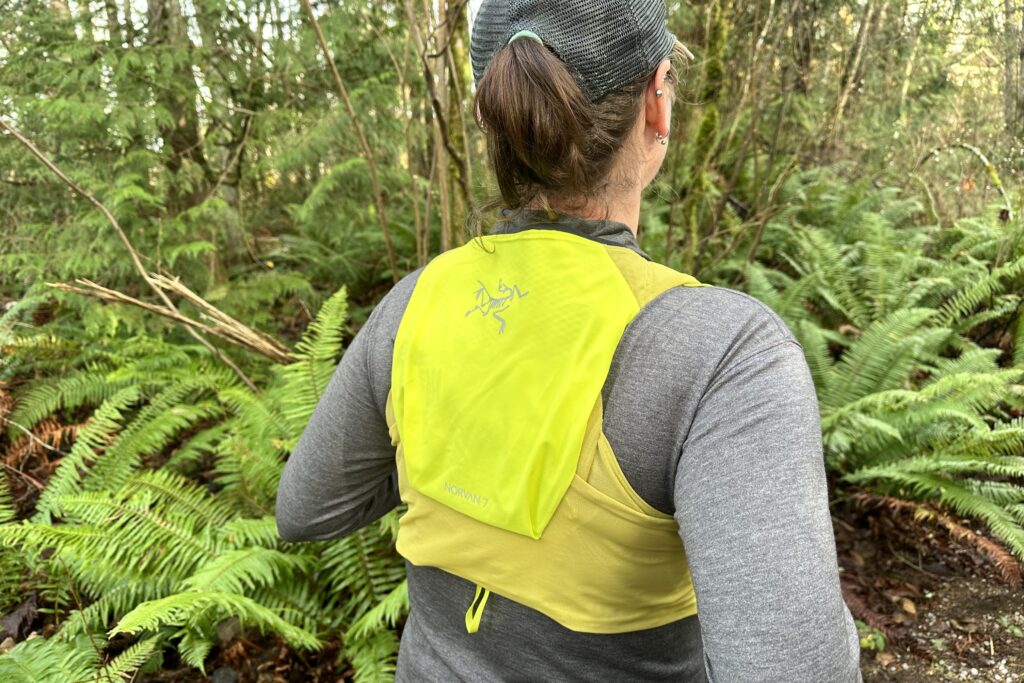
Why Trust CleverHiker
Gear Analyst Heather Anderson used to hate running. Then, after completing her first thru-hike of the Appalachian Trail, she decided that maybe she’d like running more if it was on trails. Over twenty years and tens of thousands of miles later, she hasn’t looked back.
An avid hiker, trail runner, and mountaineer she blends these modalities into fast and light travel that take her to places that people seldom go. She’s tested dozens of running vests, including the all-stars in this line up, on her training and adventures around the Pacific Northwest.

Analysis & Results
We evaluated these running vests using five key metrics: comfort, functionality, performance, breathability, and durability. Our comparative results below highlight the top performers in each category.
VALUE
Running vests can be surprisingly pricey, but like a lot of outdoor gear, they should endure a long time with proper care. Often, you’re paying more for features like ultralight fabrics or attachment options. It’s important to consider how you’ll use the vest when choosing the right one for you.
Our top-value picks include the remarkably affordable Ultraspire Alpha 5.0 Race Vest, which is also extremely well-crafted with all the features most runners need. This pack not only earned our Budget Buy badge for its low price but is also an Editor’s Pick as one of our top-ranked vests across all metrics.
Similarly, the Salomon ADV Skin 5 ranks highly in nearly every category and has all the features you’d expect from a running vest. The Osprey Dyna 6 Hydration Vest is another budget-friendly option, made from durable fabrics that will last a long time, meaning your investment per wear will be low, with high long-term value.
COMFORT
Perhaps the most important aspect of choosing a running vest is comfort and fit. Even if a pack has all the bells and whistles, it’s not the right choice if it doesn’t fit you comfortably. This becomes more significant the longer you run, and our top choices for comfort were the ones we often forgot we were wearing.
Our most comfortable vests were also our top three overall best performers: the Ultimate Direction Ultra Vest/a 6.0 Hydration Vest, the Black Diamond Distance 4, and the Ultraspire Alpha 5.0 Race Vest.
We found these packs to excel in all categories and appreciated the gender-specific cuts in the Ultra Vesta and Distance 4, as well as the multiple size options from all three brands that made getting the perfect fit easy to achieve.
FUNCTIONALITY
The functionality of a pack ultimately comes down to personal preference. Not all runners will be seeking the same features; however, in our testing, we evaluated how functional the included features in each vest were.
Once again, the Ultraspire Alpha 5.0 Race Vest, Black Diamond Distance 4, and Ultimate Direction Ultra Vest/a 6.0 Hydration Vest topped the chart. While the Vest/a and Alpha 5.0 are full-featured packs with multiple attachment points for various gear, relatively large capacity, and details like insulated hydration sleeves, the Distance 4 is a more minimal and streamlined option.
Regardless of the features provided, each vest offered functionality—from easy-access pockets to clips and closures that made them simple to use. No matter what your running goals are, one of these packs will meet your needs.
PERFORMANCE
We identified performance as a specific subset of fit and function. Although some packs were comfortable and featured good qualities, they underperformed. Once we took them onto the trail, they either bounced around, items fell out of the pockets, or other issues arose. Assessing performance can be challenging until you’ve truly tested a vest over several trips down the trails, which we did.
Our top performers once again excelled in this metric, with the Ultraspire Alpha 5.0 Race Vest and Black Diamond Distance 4 being the most secure and bounce-free on runs of any length. The Ultimate Direction Ultra Vest 6.0 Hydration Vest completed our top performers list with a bounce and chafe-free experience, only slightly affected by the chance of missing the openings of the small shoulder pockets and dropping items.
BREATHABILITY
Whether you’re running in the rain, heat, or just pushing yourself, moisture is a part of every run. Adding layers like a vest over your bra, shirt, or jacket can exacerbate moisture buildup.
We searched for wicking fabrics that draw moisture away from our bodies, similar to those used in the Black Diamond Distance 4, to keep us cool and comfortable. We also appreciated the non-absorbent materials found in the Ultraspire Alpha 5.0 Race Vest and Ultimate Direction Ultra Vest/a 6.0 Hydration Vest, which stayed dry and comfortable even on rainy days in the Pacific Northwest.
Furthermore, each of these packs featured water-resistant pocket linings that helped minimize sweat transfer to electronics, salt tabs, and layers without sacrificing breathability.
DURABILITY
The durability of a vest often indicates its value. If you’re a frequent runner, then choosing a vest based solely on price may not yield the best outcome. However, investing a little more in a solid pack that will last a long time significantly reduces your price per wear.
Our top picks here are the Salomon ADV Skin 12 and the Salomon ADV Skin 5. Salomon vests are designed for longevity without compromising on weight or functionality.
An honorable mention goes to the Osprey Dyna/Duro 6 Hydration Vest, which, although not the highest rated in some categories, boasts excellent durability and an environmentally friendly composition since it’s made from 100% recycled materials. It also ranks among the less expensive vests on the market, making it a great long-term value.
How to Choose a Running Vest
FLUID STORAGE
They’re called “hydration vests” for a reason. Whether you’re tackling a 10-mile training run or a 50-mile race, the ease, comfort, and capacity of your vest’s hydration system are crucial factors to consider. Some runners choose to carry bottles or soft flasks tucked away in the front pockets, while others prefer a bladder reservoir that rests in a back sleeve.
Flasks or bottles are more versatile and easier to refill, but a reservoir holds more water and offers hands-free hydration. Ultimately, the choice between the two comes down to personal preference and the duration of your run.
Every vest on this list, except the Arc’Teryx Norvan 7, is compatible with both reservoirs and flasks; however, remember that fluid storage isn’t always included with your purchase of a running vest. Some will come with flasks, some with reservoirs, and some won’t include either.
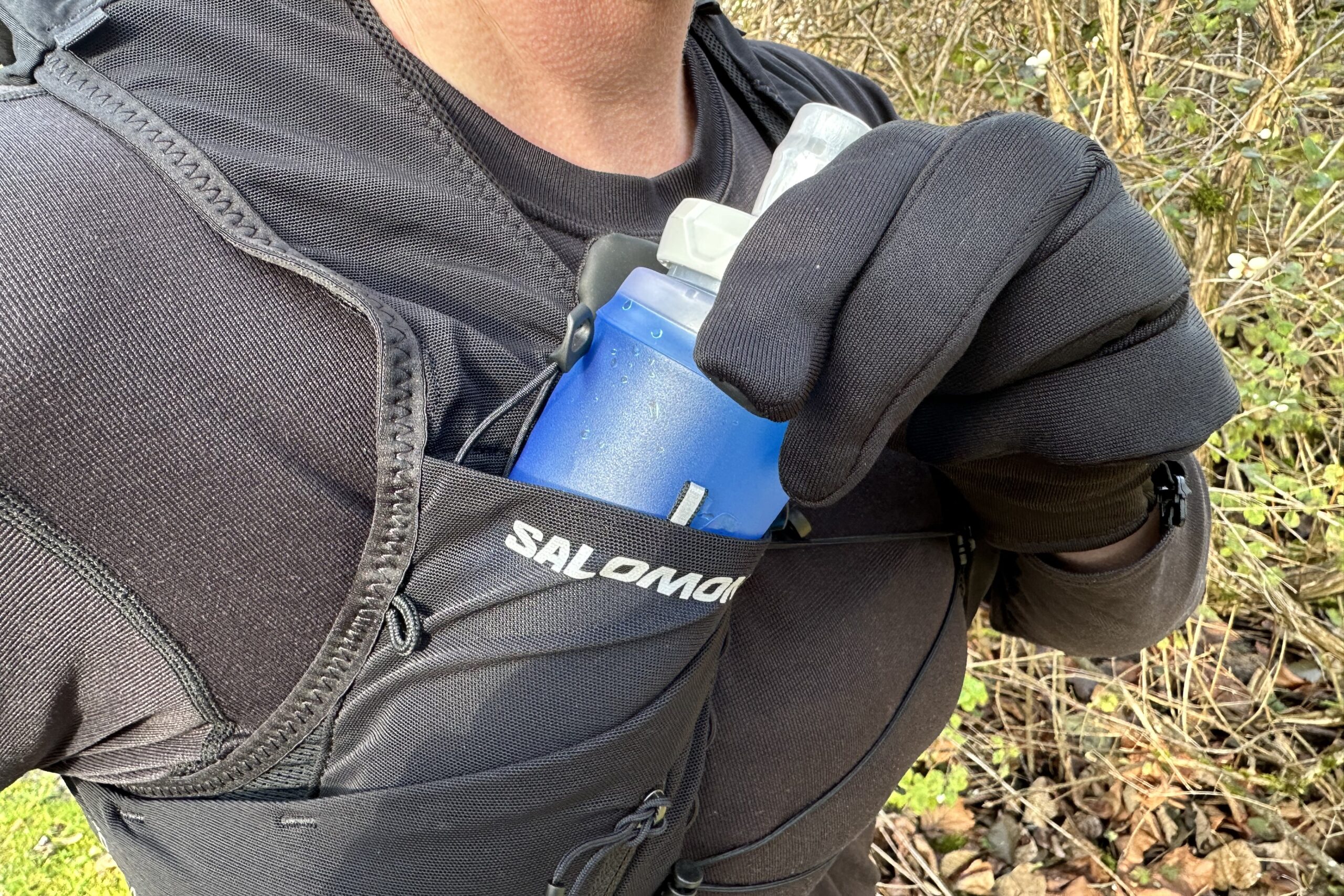
CAPACITY
The storage capacities of the vests on this list range from 4 to 12 liters. There are also smaller options designed solely for hydration, as well as vests that can hold 15, 20, or even more liters. The amount of storage space you require depends on the length and purpose of your run.
We find that for most training and racing, 4 to 12 liters offers ample space. Selecting a vest with 4 to 6 liters of storage will meet your needs during mostly fair weather and shorter runs.
For longer outings or days with unpredictable conditions, you’ll want a larger vest that can accommodate more snacks and extra layers. We recommend opting for a vest that is spacious enough to fulfill all of your needs but compressible when not fully loaded to prevent flopping or shifting during your runs.
FIT
A running vest should fit snugly around your torso to minimize bounce. If it’s too large or loose, it can shift during your runs. This can be more than just a nuisance; it may also lead to uncomfortable chafing.
When choosing a vest, be sure to check the manufacturer’s sizing guidelines and pay close attention to the adjustable straps. Many vests come with chest and underarm straps that you can adjust or even remove. Keep in mind that your vest will fit more snugly when it is full than when it is empty, so it’s strongly recommended to choose one that is highly adjustable and that your measurements fit in the middle of the size range.
Most of the vests on this list are available in multiple sizes and gender-specific cuts. If you have narrower shoulders, women’s models may fit you better than men’s or unisex sizes.
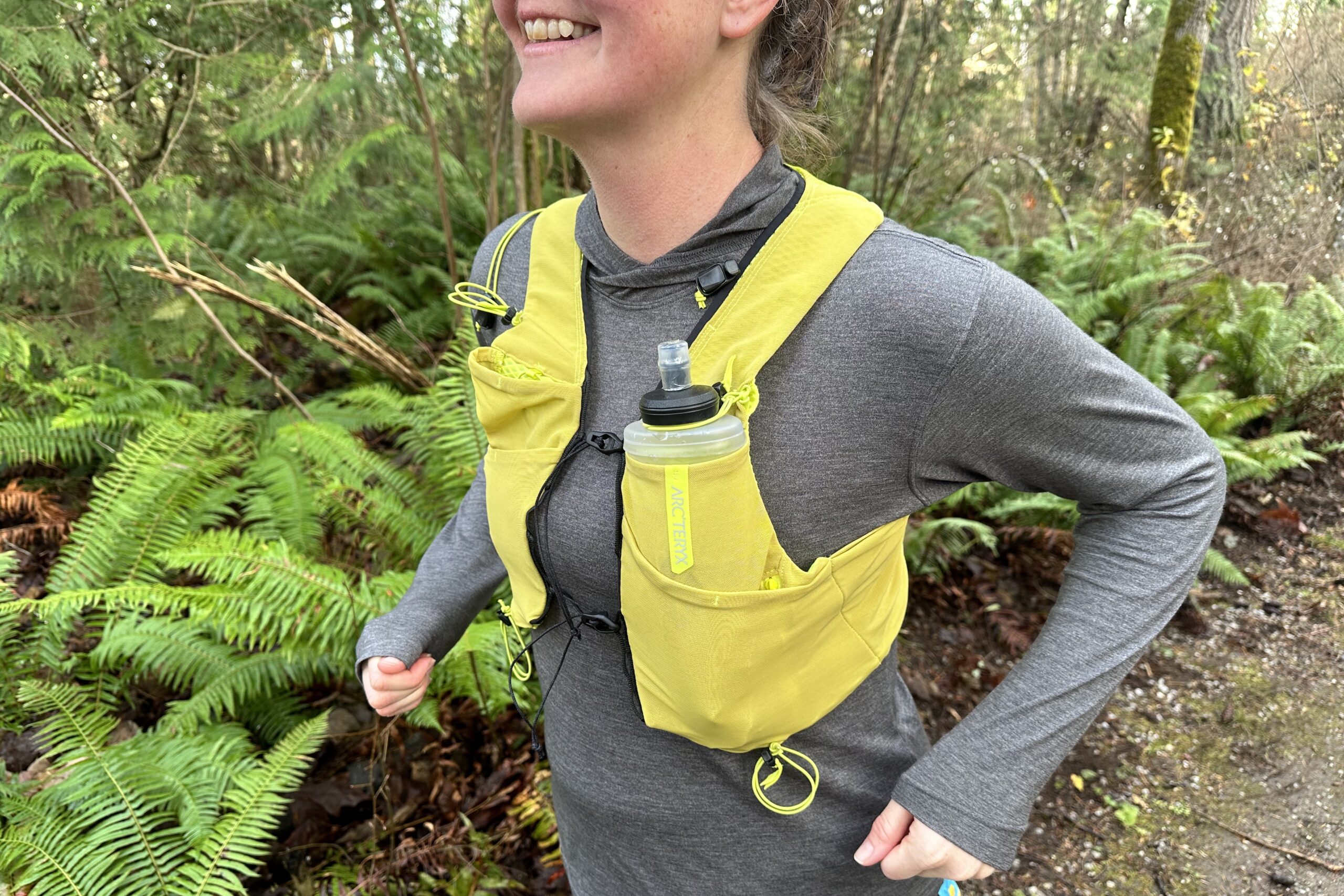
POCKET CONFIGURATION AND ACCESSIBILITY
It’s not just about the capacity of your vest; it’s also about how quickly you can access critical items like snacks, keys, and gadgets. While most vests usually have at least one front pocket that can hold a smartphone, it’s important to carefully evaluate the pocket layout before making your choice.
We recommend selecting vests with at least one zip pocket in the front and back for securing essential items and allowing easy access to several others without having to remove the vest.
ADDITIONAL FEATURES
Some runners prefer reflective and high-visibility materials for night running, while others may seek dedicated loops and straps for securing trekking poles, helmets, or ice axes during mountain runs.
Research any additional features (safety whistles, waterproof pockets, specialized materials) so that you understand exactly what you’re getting and what you’re not.
Selecting a vest with more features than you need can contribute to excess bulk, weight, and cost. Ensure your vest is compatible with where you plan to take it and how you intend to use it.
Conclusion
If your runs require you to carry more than just your keys, or if you simply prefer a hands-free hydration option, there is a hydration vest that’s perfect for you. Whether you’re searching for a race day companion or a rugged workhorse for all-day adventure runs in the mountains, we’ve vetted the best vests to help you find your ideal hydration and storage solution. Happy Trails!



